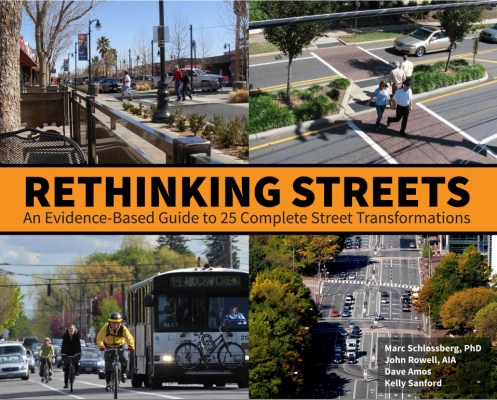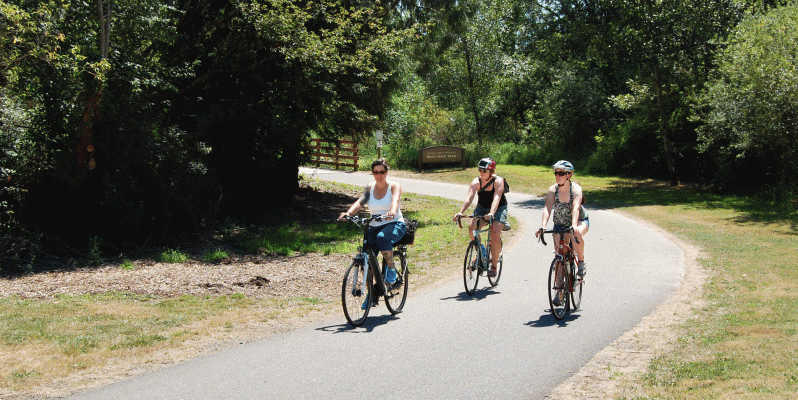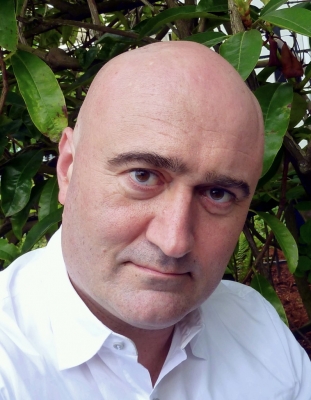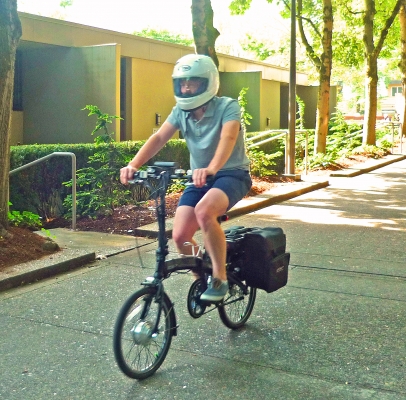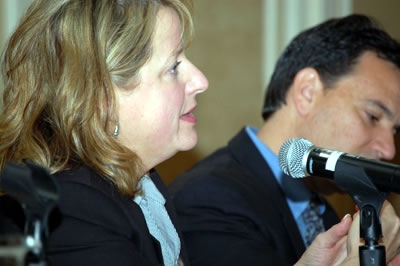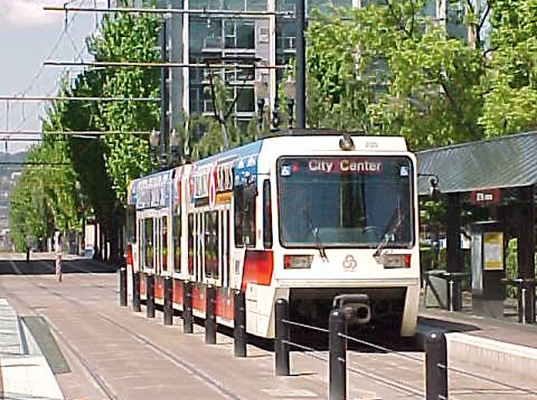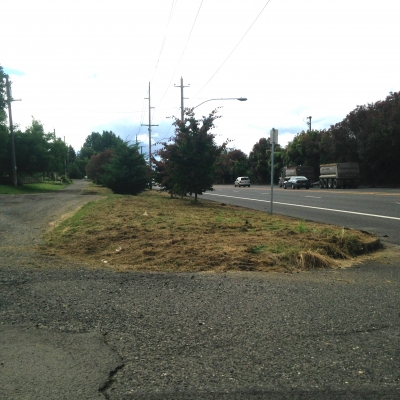Portland State University has earned a reputation for innovative transportation programs that span multiple disciplines, all in service of livable communities. That expertise is now available in a single place through the newly renamed TREC, Portland State’s transportation research and education center.
Growing out of OTREC, TREC is the steward of Portland State’s participation in the U.S. Department of Transportation’s University Transportation Centers program. The program has awarded Portland State more than $30 million since 2006, with a nonfederal match requirement amplifying the effect of the federal investment and touching more community partners.
The new website, trec.pdx.edu, lets visitors search for transportation research and researchers across campus by topic or browse by research area.
With leadership from Rep. Peter DeFazio, OTREC was founded in 2006 as a four-campus consortium and expanded into a broader transportation center. The original OTREC grant ran until 2014, funding 237 research, education and technology transfer projects. In addition to carrying on this legacy, TREC also:
- Builds on the Center for Transportation Studies, established in 1966. The longstanding ...
The Initiative for Bicycle and Pedestrian Innovation (IBPI) is teaming up with Alta Planning + Design to offer a firsthand, on-the-ground training opportunity at the end of October.
They will teach a trail design course at Portland State University, with field tours of some of Portland's biggest trail challenges and best solutions.
Course instructors are Alta associates Robin Wilcox, George Hudson, and Karen Vitkay. They will share their experience and provide examples from some of the best trails around the country.
Multi-use trails, not accessible by car but meant to be shared by pedestrians, cyclists and the occasional leashed dog, are pleasant routes by almost anyone’s standards. Often winding through wooded areas or along waterways, insulated from the noise of traffic and offering contact with nature, they present an attractive alternative to cyclists who are not as comfortable riding on busy streets.
While any segment of trail can offer a pleasant stroll, the true beauty of shared-use trails lies in being able to use them: as an alternate, off-street means of travel, a route to school or a way to get to work in the morning. A widespread switch from driving on streets to...
Read moreThe National Institute for Transportation and Communities (NITC) invites proposals for the Fall 2014 Doctoral Dissertation Research Fellowships. This grant is part of the University Transportation Center (UTC) program funded by the U.S. Department of Transportation’s (USDOT), and is a partnership between Portland State University (PSU), the University of Oregon (UO), the Oregon Institute of Technology (Oregon Tech), and the University of Utah (UU). The mission of the UTC program is to advance U.S. technology and expertise in the many disciplines comprising transportation through the mechanisms of education, research, and technology transfer at university-based centers. See utc.dot.gov for more information.
Fellowships up to $15,000 will be awarded to cover expenses for the recipient while working on their dissertation. A Spring 2015 NITC Dissertation RFP will be released in January with applications due in April 2015.
NITC is focused on contributing to transportation projects that support innovations in: livability, incorporating safety and environmental sustainability
ELIGIBILITY
Students must be a US Citizen and have advanced to candidacy for the Ph.D. degree prior to the application deadline. NITC fellowships are open to students currently enrolled in a transportation-related doctoral program at Portland State University (PSU), University of Oregon (UO), Oregon Institute of Technology (Oregon Tech),...
Read moreWith his 2011 book, “Human Transit,” consultant Jarrett Walker provided planners and community members with a new way to think about the choices transit planning requires. Since that time, Walker has focused on what transit actually delivers. He calls this concept “abundant access”: how much of your city is available to you in a short amount of time.
Walker will delve into this topic Monday, Sept. 15 as the keynote speaker at the Oregon Transportation Summit. Online registration for the summit closes Wednesday night.
“Abundant access is an interesting way to think about transit and something that brings it into the personal frame of liberty that is missing from most analysis of urban outcomes,” Walker said. “How we talk about sensations of freedom, so that we don’t just sound like bureaucrats who know what’s good for everyone.”
Urbanist leaders go astray, Walker said, when they put other goals ahead of the liberty and opportunity that useful transit provides. That could mean catering to developers or creating a symbolic transit system that is fun to ride but doesn’t serve regular transit users well.
Walker calls the New Urbanist conceit of...
Read moreIn 2009, researchers at the Massachusetts Institute of Technology (MIT) developed the Copenhagen Wheel, a device that converts an ordinary bicycle into a hybrid e-bike.
An e-bike is considered a motorized bicycle under Massachusetts law. This means that once the 13-pound, 26-inch Copenhagen Wheel is attached to the rear wheel of a bicycle, the resulting vehicle requires a driver’s license to operate, must be registered with the DMV, and its rider must wear, not just a bike helmet, but a motorcycle helmet to be in compliance with the law.
Electric bicycles, or e-bikes, are well established in China and other Asian and European countries but market adoption has been slow in the United States.
Part of the reason could be that the law is often nebulous where e-bikes are concerned.
NITC researchers at Portland State University conducted a policy review revealing the current state of legislation regarding e-bikes in the United States and Canada.
The report, Regulations of E-Bikes in North America, provides a summary of legal definitions and requirements surrounding the use of electric-assist bicycles in each of the 50 states, Washington D.C. and 13 Canadian provinces.
No two jurisdictions are exactly alike in their legal treatment of this relatively new mode...
Read more(First published by BikePortland.org)
Sue Groth’s job: use math and millions of dollars to stop injuries before they happen.
The team Groth leads at the Minnesota Department of Transportation has probably saved a few hundred lives over the last 10 years. In that time they’ve reinvented “highway safety” spending and seen traffic fatalities fall almost twice as fast as they have in Oregon and the rest of the country.
Groth is the plenary speaker at the Sept. 15 Oregon Transportation Summit hosted by OTREC at Portland State University. Michael Andersen of BikePortland spoke to her last week to talk about MnDOT’s daring decision to give up some of the “gobs of money” it gets for highway safety and hand it to local agencies instead.
What’s the nature of your work on the safety movement called Vision Zero, also known as Toward Zero Deaths?
My state happened to be one of the first to adopt it. We have had a program for over 10 years now and have had some pretty good success. We don’t have to accept the fact that 400 people a year die on the roads in Minnesota, or 33,000 nationally.
400?
Oh, I’d better give you a precise number: 387. Minnesota’s had great success. One year we actually got down to 368.
(Editor’s note:...
Read moreAn OTREC report from Oregon State University looked at various center median and bicycle lane configurations, and how they affect traffic at road access points.
In the American Association of State Highway and Transportation Officials (AASHTO) publication A Policy on Geometric Design of Highways and Streets, commonly known as the Green Book, access points include the intersections of public roads as well as driveway locations. In the Green Book, most of the supporting research for the spacing of driveways is based on standard highway design procedures. They include simple human factors and geometric principles, and have not been thoroughly evaluated based on a variety of road cross section configurations.
Principal investigator Karen Dixon of Oregon State University sought to close this research gap by evaluating the influences of select cross-sectional-related design elements, specifically median configurations and bicycle lanes, on driveways.
Dixon's research team evaluated eight physical sites and four simulated scenarios with different driveway spacing and roadway cross section designs. The primary...
Read moreTransit supporters offer up a host of arguments for their favorite form of transportation but may struggle to counter a response of “prove it.” This year’s Oregon Transportation Summit could help change that.
Fresh research showing some of the benefits of transit will keep the public transportation track lively and relevant during the sixth annual summit. Morning and afternoon workshops spotlight transit, bookending a luncheon keynote by noted transit planner Jarrett Walker.
The Oregon Transportation Summit takes place Monday, Sept. 15 at Portland State University.
University of Utah researcher Reid Ewing made national and international headlines recently with a study showing the effect of light rail in a busy travel corridor. The study, funded by the National Institute for Transportation and Communities, was the first to...
Read moreThree Portland State University graduate students in the Nohad A. Toulan School of Urban Studies and Planning used GIS technology to collect and analyze residents’ thoughts about walkability needs for Portland, Oregon’s northeast Cully neighborhood.
In PPGIS, community input is used to create GIS-based data and diagnostics maps which can inform planners’ decision-making process. Team members Travis Driessen, Brandi Campbell and Eduardo Montejo worked with community-based organizations and residents to assess the needs of the Cully neighborhood’s pedestrian network using PPGIS methods.
Prior to this project, Driessen, who is working toward a graduate certificate in Geographic Information Systems at PSU, was already collaborating with David Hampsten, a board member of the Hazelwood Neighborhood Association and member of the East Portland Action Plan, to help Prioritize Portland! – a coalition consisting of multiple organizations including the ...
Read more

